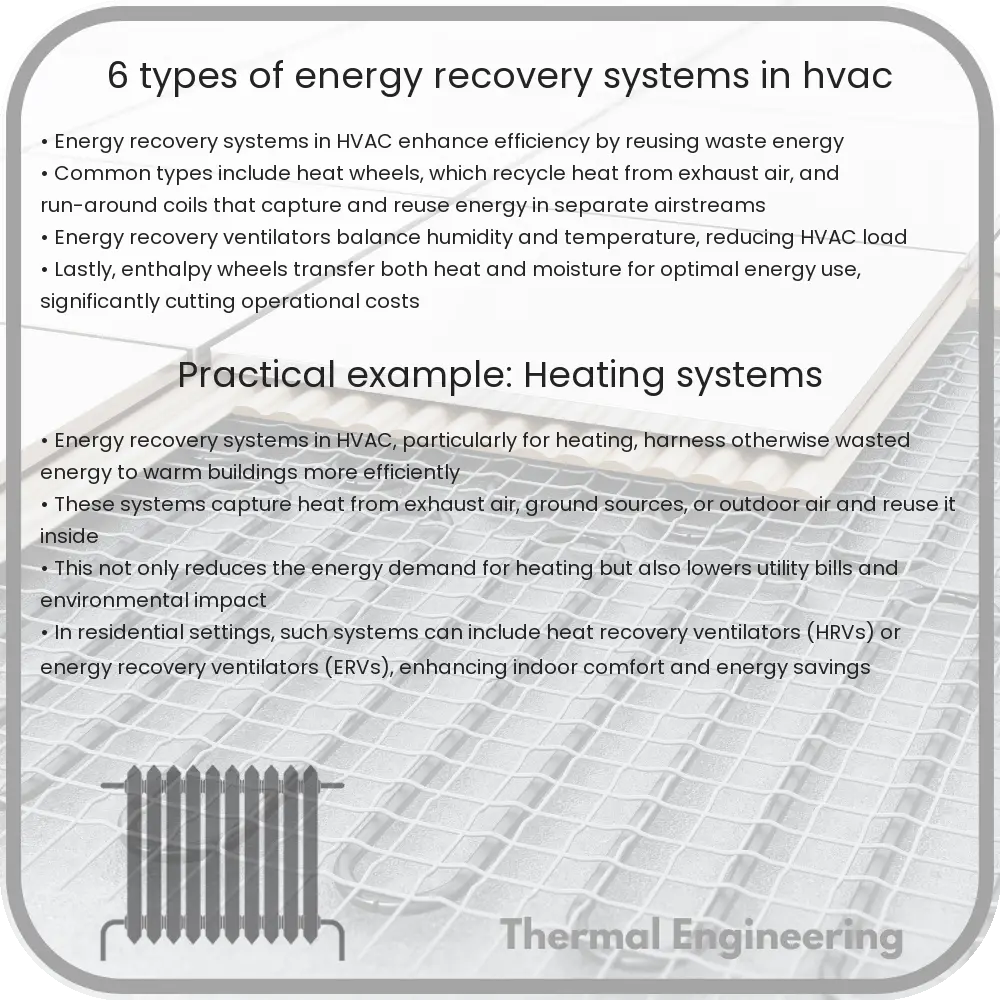Learn about energy recovery systems in HVAC, designed to reduce consumption by capturing waste heat from exhaust air to condition incoming air.

Introduction to Energy Recovery in HVAC Systems
Heating, ventilation, and air conditioning (HVAC) systems are crucial in maintaining the comfort and air quality in buildings. Energy recovery systems in HVAC are designed to reduce the energy consumption of these systems by capturing waste heat from exhausted air and using it to condition incoming fresh air. This not only conserves energy but also helps in significantly reducing utility costs and environmental impact. This article explores six common types of energy recovery systems utilized in HVAC applications.
1. Heat Wheels
Also known as rotary heat exchangers, heat wheels are one of the most effective energy recovery systems. They consist of a large wheel with a honeycomb media material that rotates between the incoming and outgoing air streams. As the wheel rotates, heat and sometimes moisture are absorbed from the exhaust air and transferred to the incoming cold air. Heat wheels are particularly effective in climates where both heating and cooling are necessary.
2. Heat Pipes
Heat pipes employ a sealed pipe containing a refrigerant that transfers heat through phase change and capillary action. Arranged in a counterflow configuration, as the warm exhaust air passes over one section of the pipe, the refrigerant evaporates, absorbing heat. The vapor then travels to a cooler section of the pipe (where the incoming air passes), condenses, and releases the absorbed heat to the incoming air. Heat pipes are highly efficient and require minimal maintenance, making them suitable for moderate climates.
3. Plate Heat Exchangers
Plate heat exchangers use metal plates to separate the incoming and outgoing air streams. Heat is transferred by conduction through the plates from the exhaust air to the colder incoming air. They are very efficient for heat transfer and can be designed for high recovery effectiveness. Because the air streams are completely separated, they also prevent cross-contamination between incoming and outgoing air.
4. Run-around Coil Systems
A run-around coil system involves two separate coils placed in the supply and exhaust air streams and connected by a loop of pipes containing a heat transfer fluid, typically water or glycol. The heat transfer fluid absorbs heat from the exhaust air as it passes through one coil, is pumped to the other coil, and releases the heat to the incoming air. This system is versatile and can be installed where the supply and exhaust air streams are not adjacent to each other.
5. Enthalpy Wheels
Enthalpy wheels are similar to heat wheels but have the added capability of transferring moisture in addition to heat. The wheel’s material is designed to adsorb not only heat but also water vapor from the exhaust air, which can be beneficial in controlling humidity levels of the incoming air. This makes enthalpy wheels particularly useful in humid or dry climates, depending on the need for humidification or dehumidification.
6. Thermosiphons
Thermosiphons operate on a principle similar to heat pipes but are driven by gravity and natural convection instead of capillary action. They are typically used in vertical installations where the warm air rising from the exhaust naturally drives the cycle of heating the refrigerant, which then moves to the cooler area to release heat to the incoming air stream. Thermosiphons are simpler than heat pipes and can be a cost-effective solution for specific architectural constraints.
Conclusion
Integrating energy recovery systems in HVAC can lead to significant energy savings and improved system efficiency. Whether it’s a simple residential setup or a large commercial building, these systems can be tailored to meet diverse climatic and spatial requirements. Understanding the different types of energy recovery options available allows engineers and architects to make informed decisions that contribute to sustainable building practices and operational cost savings.